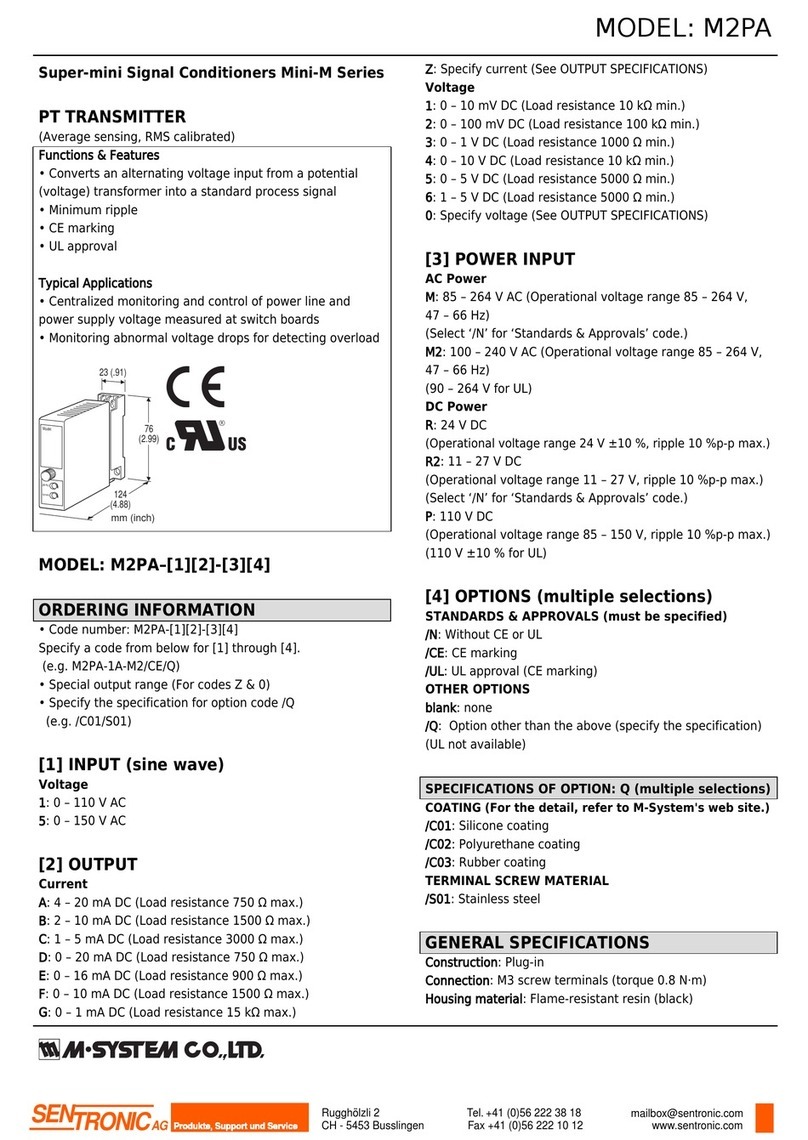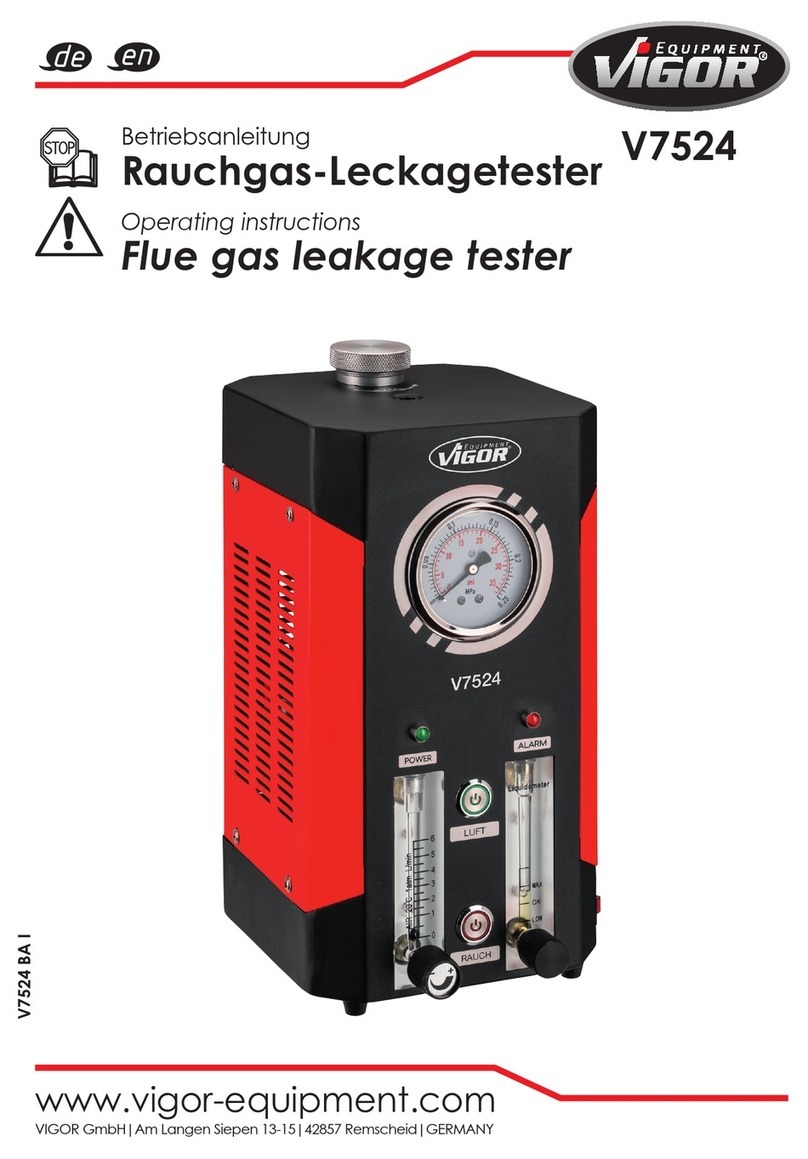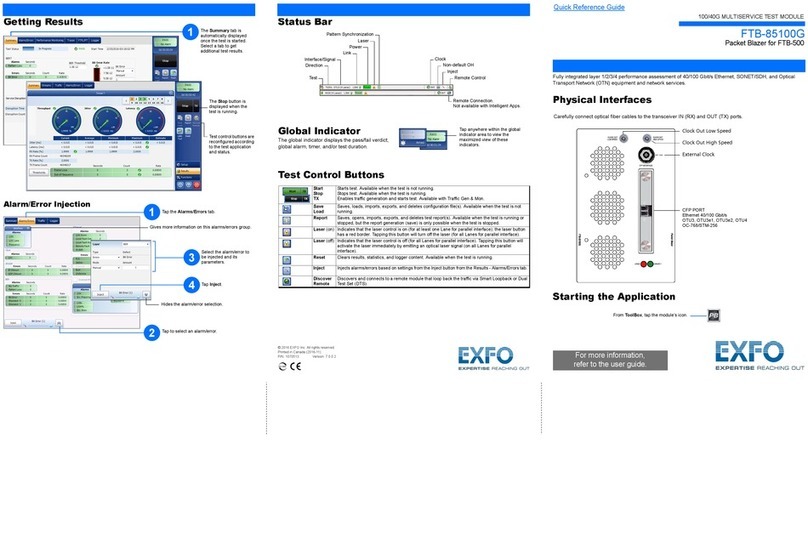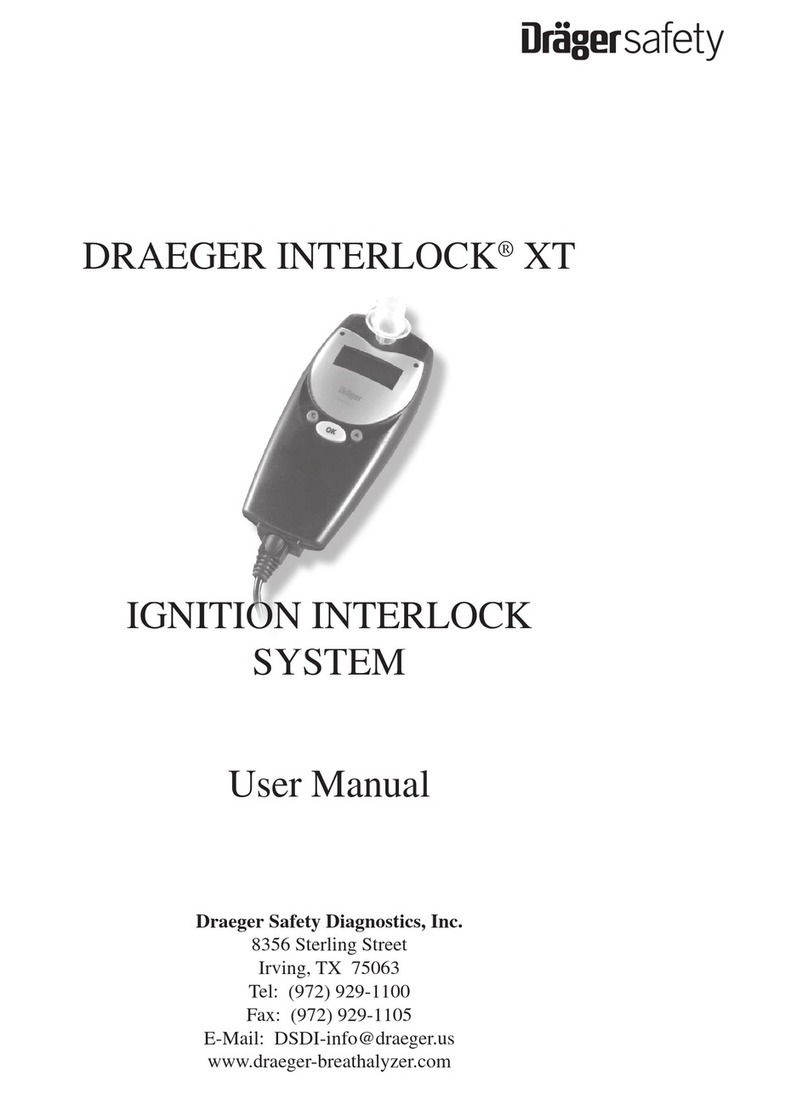IMI SENSORS 699A07 User manual

Model 699A07
PORTABLE VIBRATION CALIBRATOR
Installation and Operating Manual
For assistance with the operation of this product,
contact the PCB Piezotronics, Inc.
Toll-free: 800-959-4464
24-hour SensorLine: 716-684-0001
Fax: 716-684-3823
E-mail: [email protected]
Web: www.imi-sensors.com

The information contained in this document supersedes all similar information that
may be found elsewhere in this manual.
Service –Due to the sophisticated
nature of the sensors and associated
instrumentation provided by PCB
Piezotronics, user servicing or repair is
not recommended and, if attempted,
may void the factory warranty. Routine
maintenance, such as the cleaning of
electrical connectors, housings, and
mounting surfaces with solutions and
techniques that will not harm the
physical material of construction, is
acceptable. Caution should be observed
to ensure that liquids are not permitted
to migrate into devices that are not
hermetically sealed. Such devices
should only be wiped with a dampened
cloth and never submerged or have
liquids poured upon them.
Repair –In the event that equipment
becomes damaged or ceases to
operate, arrangements should be made
to return the equipment to PCB
Piezotronics for repair. User servicing or
repair is not recommended and, if
attempted, may void the factory
warranty.
Calibration –Routine calibration of
sensors and associated instrumentation
is recommended as this helps build
confidence in measurement accuracy
and acquired data. Equipment
calibration cycles are typically
established by the users own quality
regimen. When in doubt about a
calibration cycle, a good “rule of thumb”
is to recalibrate on an annual basis. It is
also good practice to recalibrate after
exposure to any severe temperature
extreme, shock, load, or other
environmental influence, or prior to any
critical test.
PCB Piezotronics maintains an ISO-
9001 certified metrology laboratory and
offers calibration services, which are
accredited by A2LA to ISO/IEC 17025,
with full traceability to SI through
N.I.S.T. In addition to the normally
supplied calibration, special testing is
also available, such as: sensitivity at
elevated or cryogenic temperatures,
phase response, extended high or low
frequency response, extended range,
leak testing, hydrostatic pressure
testing, and others. For information on
standard recalibration services or
special testing, contact your local PCB
Piezotronics distributor, sales
representative, or factory customer
service representative.
Returning Equipment –Following
these procedures will ensure that your
returned materials are handled in the
most expedient manner. Before
returning any equipment to PCB
Piezotronics, contact your local
distributor, sales representative, or
factory customer service representative
to obtain a Return Warranty, Service,
Repair, and Return Policies and
Instructions Materials Authorization
(RMA) Number. This RMA number
should be clearly marked on the outside
of all package(s) and on the packing
Service, Repair, and Return
Policies and Instructions

list(s) accompanying the shipment. A
detailed account of the nature of the
problem(s) being experienced with the
equipment should also be included
inside the package(s) containing any
returned materials.
A Purchase Order, included with the
returned materials, will expedite the
turn-around of serviced equipment. It is
recommended to include authorization
on the Purchase Order for PCB to
proceed with any repairs, as long as
they do not exceed 50% of the
replacement cost of the returned
item(s). PCB will provide a price
quotation or replacement
recommendation for any item whose
repair costs would exceed 50% of
replacement cost, or any item that is not
economically feasible to repair. For
routine calibration services, the
Purchase Order should include
authorization to proceed and return at
current pricing, which can be obtained
from a factory customer service
representative.
Contact Information –International
customers should direct all inquiries to
their local distributor or sales office. A
complete list of distributors and offices
can be found at www.pcb.com.
Customers within the United States may
contact their local sales representative
or a factory customer service
representative. A complete list of sales
representatives can be found at
www.pcb.com. Toll-free telephone
numbers for a factory customer service
representative, in the division
responsible for this product, can be
found on the title page at the front of this
manual. Our ship to address and
general contact numbers are:
PCB Piezotronics, Inc.
3425 Walden Ave.
Depew, NY14043 USA
Toll-free: (800) 828-8840
24-hour SensorLineSM: (716) 684-0001
Website: www.pcb.com

PCB工业监视和测量设备 - 中国RoHS2公布表
PCB Industrial Monitoring and Measuring Equipment - China RoHS 2 Disclosure Table
部件名称
有害物质
铅(Pb)
汞
(Hg)
镉
(Cd)
六价铬(Cr(VI))
多溴联苯 (PBB)
多溴二苯醚(PBDE)
住房
O
O
O
O
O
O
PCB板
X
O
O
O
O
O
电气连接器
O
O
O
O
O
O
压电晶体
X
O
O
O
O
O
环氧
O
O
O
O
O
O
铁氟龙
O
O
O
O
O
O
电子
O
O
O
O
O
O
厚膜基板
O
O
X
O
O
O
电线
O
O
O
O
O
O
电缆
X
O
O
O
O
O
塑料
O
O
O
O
O
O
焊接
X
O
O
O
O
O
铜合金/黄铜
X
O
O
O
O
O
本表格依据 SJ/T 11364 的规定编制。
O:表示该有害物质在该部件所有均质材料中的含量均在 GB/T 26572 规定的限量要求以下。
X:表示该有害物质至少在该部件的某一均质材料中的含量超出 GB/T 26572 规定的限量要求。
铅是欧洲RoHS指令2011/65/ EU附件三和附件四目前由于允许的豁免。
CHINA RoHS COMPLIANCE

DOCUMENT NUMBER: 21354
DOCUMENT REVISION: D
ECN: 46162
Component Name
Hazardous Substances
Lead
(Pb)
Mercury
(Hg)
Cadmium
(Cd)
Chromium VI
Compounds
(Cr(VI))
Polybrominated
Biphenyls
(PBB)
Polybrominated
Diphenyl
Ethers (PBDE)
Housing
O
O
O
O
O
O
PCB Board
X
O
O
O
O
O
Electrical
Connectors
O
O
O
O
O
O
Piezoelectric
Crystals
X
O
O
O
O
O
Epoxy
O
O
O
O
O
O
Teflon
O
O
O
O
O
O
Electronics
O
O
O
O
O
O
Thick Film
Substrate
O
O
X
O
O
O
Wires
O
O
O
O
O
O
Cables
X
O
O
O
O
O
Plastic
O
O
O
O
O
O
Solder
X
O
O
O
O
O
Copper Alloy/Brass
X
O
O
O
O
O
This table is prepared in accordance with the provisions of SJ/T 11364.
O: Indicates that said hazardous substance contained in all of the homogeneous materials for this part is below the limit
requirement of GB/T 26572.
X: Indicates that said hazardous substance contained in at least one of the homogeneous materials for this part is above
the limit requirement of GB/T 26572.
Lead is present due to allowed exemption in Annex III or Annex IV of the European RoHS Directive 2011/65/EU.

User Manual
Portable Vibration
Calibrator
699A07
69142
REV. A

IMI Sensors: A PCB Piezotronics Div 699A07 User Manual
MAN-0192 rev A Page 2 of 39 800-959-4464
MODEL 699A07 Portable Vibration Calibrator User Manual
Product Support
For answers to questions about the 699A07 Portable Vibration Calibrator, consult this manual. For
additional product support, contact IMI Sensors at 800-959-4464 in the U.S.A. or 716-684-0003, 9
a.m. to 5 p.m. EST. If it is more convenient, fax questions or comments to IMI Sensors at 716-
684-3823 or email our sales staff at [email protected]m.
Warranty
IMI Sensors Model 699A07 Portable Vibration Calibrator is warranted against defective materials
and workmanship for TWO YEARS from the date of shipment, unless otherwise specified.
Damage to equipment caused by incorrect power, misapplication or procedures inconsistent with
this manual are not covered by warranty. If there are any questions concerning the intended
application of the product, contact IMI Sensors. Batteries and other expendable accessory
hardware items are excluded.
Copyright
Copyright ã 2017 IMI Sensors. This manual is copyrighted with all rights reserved. The manual
may not be copied in whole or in part for any use without prior written consent of IMI Sensors.
Disclaimer
The following paragraph does not apply in any state or country where such statements are not
agreeable with local law:
IMI Sensors provides this publication “as is” without warranty of any kind, express or implied,
including but not limited to, the implied warranties of merchantability or fitness for a particular
purpose. This document is subject to change without notice and should not be construed as a
commitment or representation by IMI Sensors.
This publication may contain inaccuracies or typographical errors. IMI Sensors will periodically
update the material for inclusion in new editions. Changes and improvements to the product
described in this manual may be made at any time.
Trademarks
ICP® is a registered trademark of PCB Piezotronics, Inc. Pelican® is a trademark of
Pelican Products, Inc.
MAN-0192 Rev A
October 2017
3425 Walden Avenue
Depew, NY 14043
Phone: 716.684.0001
Fax: 716-684-0987
www.pcb.com
69142
REV. A

IMI Sensors: A PCB Piezotronics Div 699A07 User Manual
MAN-0192 rev A Page 3 of 39 800-959-4464
Table of Contents
INTRODUCTION ............................................................................................................................. 4!
Welcome ............................................................................................................................ 4!
Customer Support .............................................................................................................. 4!
Cautionary Notes ................................................................................................................ 4!
Supplied Accesories ........................................................................................................... 5!
Optional Fixturing and Accessories .................................................................................... 6!
Replacement Accessories .................................................................................................. 6!
699A07 OPERATION GUIDE ......................................................................................................... 7!
Basic Operation .................................................................................................................. 7!
Report Generation Workbook ............................................................................................. 9!
Additional Features ........................................................................................................... 11!
Calibration Route .............................................................................................................. 13!
Definition of Frequency Units ........................................................................................... 18!
Definition of Amplitude Units ............................................................................................ 18!
Mounting Basics ............................................................................................................... 19!
Input / Output .................................................................................................................... 19!
THEORY OF OPERATION ........................................................................................................... 21!
Instrumentation ................................................................................................................. 21!
Battery and Charger ......................................................................................................... 23!
Battery Information and Care ........................................................................................... 23!
SPECIFICATIONS AND PERFORMANCE .................................................................................. 24!
General ............................................................................................................................. 24!
Accuracy of Readout ........................................................................................................ 24!
Units of Readout ............................................................................................................... 24!
Power Requirements ........................................................................................................ 25!
Temperature ..................................................................................................................... 25!
Physical ............................................................................................................................ 25!
Shaker Loading ................................................................................................................ 25!
RECOMMENDED PRACTICES .................................................................................................... 28!
Operational Verification and Recalibration ....................................................................... 28!
Standard Checks for Transducers .................................................................................... 28!
Typical Accelerometer & Velocity Sensor Checkout ........................................................ 29!
Calibrating Charge-Mode Accelerometers ....................................................................... 30!
Non-Contact Displacement Sensor Calibration ................................................................ 30!
Non-Contact Displacement Sensor Test Setup ................................................................ 31!
Proximity Probe Dynamic Linearity Calibration & Confirmation of Vibration Alarms ........ 35!
Troubleshooting the proximity probe system .................................................................... 36!
Creating a Proximity Probe Curve in Mils ......................................................................... 36!
Testing 4-20 mA Vibration Transmitters ........................................................................... 37!
Maintenance ..................................................................................................................... 39!
69142
REV. A

IMI Sensors: A PCB Piezotronics Div 699A07 User Manual
MAN-0192 rev A Page 4 of 39 800-959-4464
Introduction
Welcome
Thank you for choosing IMI Model 699A07.
The IMI Model 699A07 Portable Vibration Calibrator provides a field tested method
for on-the-spot dynamic verification of accelerometers, velocity pickups and non-
contact displacement transducers. Optional mounting fixtures and hardware
needed to connect transducers to the 699A07 mounting platform are available upon
request.
A closed-loop control algorithm provides enhanced stability and accuracy of
frequency and amplitude levels.
The 699A07 incorporates a built-in sine wave oscillator, power amplifier,
electrodynamic shaker, NIST traceable reference accelerometer, digital display, and
internal memory. The 699A07 is completely self-contained and operates on battery
or AC power.
The built-in reference accelerometer is attached permanently to the shaker
armature, maximizing the accuracy between the reference accelerometer and the
test transducer. The 699A07 is designed to provide long-term reliable performance
over the frequency range of 5 Hz to 10 kHz. The 699A07 can be used for a variety
of applications that include:
• Verification and calibration of vibration transducers and related vibration
test systems
• Verification of connector and cabling integrity
• Confirm machine vibration alarm trip points are set properly and ensure
end-to-end functionality of vibration monitoring systems.
Customer Support
IMI Sensors is a PCB Group Company, and we are 100% committed to the PCB
Group’s pledge of ‘Total Customer Satisfaction.’ If at any time you have questions
or problems with the 699A07 system, please contact an Application Engineer at IMI
Sensors:
Telephone: 716-684-0001
Toll Free: 800-828-8840
Email: imi@pcb.com
Cautionary Notes
• Loads of up to 800 gram (28.3 oz) can be mounted directly to the
699A07 mounting platform. Larger loads may be applied to the platform,
however, if prolonged testing of a heavy load is planned, we recommend
using an external transducer suspension system. Under these
conditions the vibration waveform should be viewed on the oscilloscope
to aid in positioning the test transducer and platform to reduce distortion
that can occur with very heavy weights.
• The 699A07 should always be operated on a stable, flat surface.
69142
REV. A

IMI Sensors: A PCB Piezotronics Div 699A07 User Manual
MAN-0192 rev A Page 5 of 39 800-959-4464
• The 699A07 is designed for field test applications but care must be taken
to maintain the integrity of the mounting platform assembly.
• Hearing protection recommended when operating the 699A07 for an
extended amount of time.
Supplied Accessories
Accessories pictured below are included with each 699A07 Portable Vibration
Calibrator.
USB Flash Drive Pre-Loaded with Report Generating Worksheet
Mounting Wrench
1 – Mounting Pad (080A118)
2 – ¼-28 to ¼-28 Adaptor (081B20)
3 – 10-32 to ¼-28 Adaptor
(081A08)
Accessory Pouch
Universal Power Supply
and Plug Adaptors (600A25)
69142
REV. A

IMI Sensors: A PCB Piezotronics Div 699A07 User Manual
MAN-0192 rev A Page 6 of 39 800-959-4464
Optional Fixturing and Accessories
For operation in certain applications, such as calibration of non-contact
displacement sensors, IMI offers optional mounting fixturing. Reference the table
below when ordering these optional adaptors and accessories.
Accessory
Description
600A22
Proximity probe adaptor kit, supports probes with common case
threads ranging from M6 to 3/8”. Includes Mitutoyo micrometer
and nickel plated 4140 steel target.
600A23
Proximity probe adaptor kit, supports probes with common case
threads ranging from M6 to 3/8”. Includes Mitutoyo micrometer
(metric) and nickel plated 4140 steel target.
600A24
Mounting accessory kit for 699A07 Series Portable Vibration
Calibrators to adapt to ¼-28 threaded mounting platforms.
Includes studs/inserts (1/4-38, 10-32, 6-32 and 5-40) and bases
(for adhesive, magnetic and custom thread patterns).
Replacement Accessories
Accessory
Description
600A25
18 Volt, 1 amp power supply/charger for 699A07 Portable
Vibration Calibrator, universal 100-240 V, 50/60 Hz.
600A26
Replacement battery for 699A07 Series Portable Vibration
Calibrators.
69142
REV. A

IMI Sensors: A PCB Piezotronics Div 699A07 User Manual
MAN-0192 rev A Page 7 of 39 800-959-4464
699A07 Operation Guide
For the following section, “point” is defined as the numerical value of the amplitude
at a given frequency. “Record” is defined as the collection of all numerical calibration
points at different frequencies and amplitudes saved together.
Basic Operation
For the basic operation of the 699A07, a vibration sensor and appropriate cable are
needed. Typically, the 699A07 is used as a vibration excitation source and as a
readout device with the vibration sensor connected to the 699A07’s Test Sensor
BNC Input. Alternatively, the 699A07 unit can be used to test different types of
vibration equipment (i.e. a vibration meter or vibration monitoring system), in which
case the sensor will be directly connected to the vibration measurement equipment
and the 699A07 is used just as a controlled excitation source.
Test Setup
1. Mount your sensor to the 699A07 mounting platform
• The 699A07 sensor mounting platform is threaded for a ¼-28 stud. Select an
appropriate adaptor for mounting the sensor.
• While tightening the sensor, secure the 699A07 mounting platform with the supplied
wrench to prevent damage from torque.
2. Connect sensor under test (SUT) to “Test Sensor In.” Make sure that connections are
secure.
3. Power the unit ON by pressing and holding the FREQUENCY dial for 3 seconds.
NOTE: It is good practice to perform calibrations on battery power. Disconnecting
from line power ensures a power surge will not cause the calibrator to power down
during test. If excess current is detected during use, the portable calibrator shuts
down to prevent damage.
Selecting Input Mode
4. The 699A07 can accept ICP® as well as AC voltage and AC current output sensors.
Press and hold the AMPLITUDE dial to select between ICP®, Voltage Mode or
Modulated Current mode. Modulated Current mode is only available if the firmware
option is ordered, otherwise user will not see this mode as an option.
Note: ICP® (or IEPE) mode sensors are the most popular type of accelerometer
transducers and require a 2 mA to 20 mA constant current supply to operate.
The 699A07 unit supplies the necessary constant current to power this class of sensors.
Voltage output sensors are typically moving coil velocity sensors but can also be the
voltage output of a signal conditioner associated with any type of vibration transducer
such as the output from the probe driver in a proximity probe system. Refer to the Sensor
Signal Measurement Electronics (SUT Input Characteristics and Considerations) for
details.
Setting the Frequency and Amplitude Units
5. Select the correct Frequency Units for your test by pressing the FREQUENCY dial to
enter into the CALIBRATION OPTIONS menu:
• Use the FREQUENCY dial to highlight TEST SETTINGS then press.
• Within the Test Settings Menu rotate the FREQUENCY dial to highlight
FREQUENCY UNIT then press to toggle between Hertz and CPM.
69142
REV. A

IMI Sensors: A PCB Piezotronics Div 699A07 User Manual
MAN-0192 rev A Page 8 of 39 800-959-4464
6. Select the correct Amplitude Units for your test by pressing and releasing the
AMPLITUDE dial. The following options are available:
Acceleration
Velocity
Displacement
g’s pk
g’s RMS
m/s2 pk
m/s2 RMS
in/s pk
in/s RMS
mm/s pk
mm/s RMS
mils p-p
µm p-p
7. Select the desired vibration amplitude and frequency for testing by turning the
AMPLITUDE and FREQUENCY dials clockwise to increase or counter clockwise to
decrease the setting.
• Slow Turns – settings will increase or decrease by single steps
• Fast Turns – settings will increase or decrease by larger increments
Record and Save Calibration Points
8. Once the frequency and amplitude are set to desired values, with the file menu set to
“Save Point,” press the FILE dial to store the calibration data point.
9. Repeat steps 7 through 9 to set the frequency and amplitude to increment to the next
calibration data point and save.
Completing and Storing Record to Memory
10. Once all data points have been saved in a record and record is complete, rotate FILE
dial and press it to select “End Record.”
• The screen will prompt with:
11. Rotate the FILE dial to “Edit” to enter the model number, serial number and axis. The
FILE menu for this screen also includes the tools “Next” and “Back.”
• Push the FILE dial to choose “Next,” which goes to the next save screen.
12. To “Save” the record without inputting an annotation, press the FILE dial two more times.
13. Rotate the FILE dial to “Edit” and press to store any annotations or additional notes (such
as technician initials, etc):
69142
REV. A

IMI Sensors: A PCB Piezotronics Div 699A07 User Manual
MAN-0192 rev A Page 9 of 39 800-959-4464
• Turn the FILE dial to the left and right to select each individual letter or number you
wish to input as part of an annotation. Push the FILE dial to save each character.
• Rotate the FILE dial and select “Save.” This will save all data points in the listed
record number. The record number shown on the screen increments automatically.
Transfer Records to USB Flash Drive
14. Rotate FILE dial and press to select “Tools.”
15. Rotate FILE dial and press to select “USB Menu.”
• A USB flash drive must be connected to the unit. The USB must be formatted to
FAT32. You can use the 699A07 or a PC to format the flash drive.
16. To copy all data points and records to a USB Flash Drive, rotate FILE dial and press to
select “Copy All Records.”
• This will leave current records on unit memory and also create a copy on the USB.
17. To move all data points and records to USB, rotate FILE dial and press to select “Move
All Records.”
• This will remove current records on unit memory and move onto the USB.
Note: The USB hardware may not always recognize a USB flash drive if it is
plugged into the USB port while the 699A07 is in sleep mode. IMI Sensors
recommends connecting the USB drive while the 699A07 is on and operational.
Powering Off
19. Suggested Best Practice: Before powering the unit OFF, reduce the vibration
amplitude. The 699A07 retains the settings used prior to shutdown when it is
powered back ON. Reducing the amplitude prior to shutdown ensures the sensor
under test will not be jarred when the 699A07 is powered ON.
20. Power the unit OFF by pressing and holding the FREQUENCY dial for
approximately 3 seconds.
• To preserve battery charge, the 699A07 will automatically power off after 20
minutes of inactivity when not plugged in to the charger.
After Testing
21. Suggested Best Practice: Plug the 699A07 into an AC power source when not
in use. This will ensure the batteries are fully charged for your next test and also
help to maximize the lifespan of the batteries.
22. Periodic calibration checks are recommended:
• A dedicated “verification sensor” can be used to check the system readings and
results. By using a dedicated sensor, you can ensure that the system is providing
the same result during each test.
• The 699A07 should be returned to IMI Sensors for regular recalibration or for any
maintenance or repair. The most current factory calibration date or the calibration
due date is displayed on the LCD screen during the 699A07 boot up sequence. The
default due date is set for 12 months after the last factory calibration, but the
calibration interval can be user defined to be anywhere from 1 to 72 months, or set
up to never expire.
Report Generation Workbook
Calibration data can be saved into the 699A07’s internal memory and easily
exported to a personal computer using a USB Flash Drive.
The 699A07 Portable Vibration Calibrator includes a pre-formatted USB Flash Drive
with a Microsoft Excel Report Generation Workbook for the creation of customizable
calibration certificates. The Excel file provides an intuitive interface which allows a
69142
REV. A

IMI Sensors: A PCB Piezotronics Div 699A07 User Manual
MAN-0192 rev A Page 10 of 39 800-959-4464
user to create and print a calibration certificate with just a few mouse clicks. In order
to use the file, make sure macros are enabled, otherwise Excel won’t be able to load
data and create the certificates.
The Excel workbook consists of the following worksheets or tabs:
• FRData – Use this tab to create a frequency response certificates in just 2 steps:
1. Clicking on Import Data from File button prompts the user to select and import a
.csv calibration data file previously created by the 699A07
2. Once data is loaded into the table, click View Certificate to see and print a
calibration certificate containing the frequency response data (the reference
frequency for the calibration certificate is 100Hz and can be changed by the user as
needed)
Note: If testing a charge-mode accelerometer and calibration certificate in pC
units is desired, click the box at top left of the FRData tab and enter the sensitivity of
the charge amplifier in the “mV/pC” box located at cell D8. See the section
“Calibrating Charge-Mode Accelerometers” for more information.
• LINData – Use this tab to create linearity response certificates. The worksheet
applies linear regression to interpolate the data. The Max Linearity is calculated for
the worst deviation of a particular point from the best-fit straight line (BFSL) of all
tested points. The table also displays the specific results at each test level.
The LINData worksheet has 2 tables. The left table should be used for creating
dynamic linearity data calibration certificates in just 2 steps:
1. Click on Import Data from File to select and import a .csv calibration data file
previously created by the 699A07
2. Once data is loaded into the table, click View Certificate to see and print a
calibration certificate containing the linearity response data. The worksheet expects
the data points to be taken at the same frequency (speed). A checkbox option
labeled Set Y-intercept to zero is available to force the interpolation to go through
the origin point.
The right table in the LINData worksheet is used to create a DC proximity probe
curve or linearity certificate for 4-20 mA vibration transmitter. Creating a DC
proximity probe curve requires the 600A22 or 600A23 proximity probe adaptor kits
and a DC voltmeter (not included). Creating a linearity certificate for a 4-20 mA
vibration transmitter requires DMM set to DC current input.
1. Select the appropriate vibration scale (Acceleration, Velocity or Displacement) by
clicking in cell H12 and selecting from drop down menu.
2. Select the appropriate units (g’s pk, g’s RMS, m/sec2 pk, m/sec2 RMS, in/sec pk,
in/sec RMS, mm/sec pk, mm/sec RMS, mils p-p or µm p-p) in cell H13. Make sure
cell H12 is set to the right scale first.
3. Enter known amplitude and output for the first test point next to “Starting Point”
and repeat for each additional test point moving down the table. Once data is
entered into the table, click View Certificate to see and print a calibration certificate
containing the linearity response data.
• FRCert - Displays the frequency response calibration certificate using the current
data and information from FRData.
• LINCert - Displays the linearity response calibration certificate using dynamic
linearity data from LINData.
• SLINCert - Displays the linearity response calibration certificate using static
linearity data from LINData.
69142
REV. A

IMI Sensors: A PCB Piezotronics Div 699A07 User Manual
MAN-0192 rev A Page 11 of 39 800-959-4464
• Route Creator – If firmware option 600A31 is ordered, this tab can be used to
create semi-automated tests with instant pass/fail notification for almost any
vibration sensor. See “Calibration Route” for more information.
Additional Features
Delete
The “Delete” feature can be found under the FILE dial > “Delete.” When “Delete” is
selected, the shaker will stop moving and four options will appear:
1. “Delete Point” will delete a current point.
2. “Delete Record” will delete the entire current record.
3. “Delete All” will delete all data points and all records that are stored on the internal unit
memory.
4. “Back” will return to the main screen.
USB Options
The “USB Options” feature can be found under the FILE dial > “Tools” > “USB
Menu” > “USB Options.” When “USB Options” is selected, the following information
will appear on the screen:
• “Status” – USB flash drive connected or not connected.
• “Partition” – Format of USB flash drive connected to the unit.
• “Available” – Memory space available on USB flash drive.
• “Required” – Space required to save all records on USB flash drive.
And the following actions are available:
• “Eject Drive” will safely eject the USB flash drive from the unit.
• “Format USB” for formatting the USB flash drive. (FAT32 partition)
• “Back” to go back to the USB Menu.
Date and Time
The “Date and Time” feature can be found under the FILE dial > “Tools” > “Options”
> “Date and Time.”
1. Press the FILE dial to select “Adjust.”
2. Turn the AMPLITUDE dial to the select the current month, day and year and push the
FREQUENCY dial to confirm or the AMPLITUDE dial to change.
3. Press the AMPLITUDE dial to select “yes” this is correct.
4. Turn the AMPLITUDE dial to select the current hours and minutes then push the
FREQUENCY dial to confirm the time is correct.
5. Press the AMPLITUDE dial to select “yes” this is correct.
Calibration Interval
The “Calibration Interval” can be adjusted under the FILE dial > “Tools” > “Options”
> “Calibration Interval.”
1. Select “Adjust” and press FILE dial.
2. Turn AMPLITUDE dial to select number of months for Calibration Interval.
• Suggested Best Practice: 12 months. The calibration interval can be defined to be
anywhere from 1 to 72 months, or set up to never expire.
3. Press FREQUENCY dial to confirm selected Calibration Interval.
Traceability
The “Traceability” feature can be found under FILE dial > “Tools.”
69142
REV. A

IMI Sensors: A PCB Piezotronics Div 699A07 User Manual
MAN-0192 rev A Page 12 of 39 800-959-4464
1. Press FILE dial to select “Traceability.” A screen with the following information will
appear:
• Model
• Serial Number
• Firmware Revision Number
• Calibration Date
• Reference Sensor Sensitivity
• PRD-P
• NIST Traceability Number
• PTB Traceability Number
2. Press FILE dial to go back to main screen and shaker will go back to shaking.
Test Settings
The “Test Settings” menu can be found by pressing FREQUENCY dial > “Test
Settings.” A screen with the following will appear, use the FREQUENCY dial to
highlight and toggle all settings:
• Back – returns user to “Calibration Options” menu
• Cal Route: N/A, Active or off
o N/A indicates the Calibration Route firmware option has not been
purchased. Calibration Route allows users to program semi-automated test
points with instant pass/fail notification. See “Calibration Route” section for
more information. Contact IMI Sensors to unlock this feature.
• Source: Internal or External
o If external is selected the shaker can be controlled with an external source.
See “Input/Output” for more information.
• Frequency Unit: Hertz or CPM (cycles per minute)
• Sensor Type: ICP®, Voltage or Modulated Current
o Use ICP® for most accelerometers, Voltage for proximity probes and
moving coil sensors, Modulated Current for high-temp turbine vibration
sensors with AC current output. See “Selecting the Input Mode” for more
information. Modulated current is optional; contact IMI Sensors to unlock
this feature.
• Sensor Readout: mV/EU or mV
o Changes the display to show the sensor under test’s sensitivity (output
voltage divided by input vibration, mV/EU) or the sensor under test’s raw
AC output voltage.
Amplitude Units
Amplitude units that are seldom or never used can be turned off by using the
“Amplitude Units” feature, found by pressing FREQUENCY dial > “Amplitude Units.”
The “Amplitude Unit Screen” shows all 10 available amplitude scales on model
699A07 Portable Vibration Calibrator. Use the FREQUENCY dial to highlight each
scale and press the dial to toggle the scale on or off. A filled circle next to the scale
indicates it is active. An empty circle next to the scale indicates it is inactive. Inactive
scales do not appear when cycling through scales using the AMPLITUDE dial
during normal operation.
69142
REV. A

IMI Sensors: A PCB Piezotronics Div 699A07 User Manual
MAN-0192 rev A Page 13 of 39 800-959-4464
To go back to the “Calibration Options” menu use the FREQUENCY dial to highlight
“Back” then press.
Calibration Route
Firmware Option: 600A31
The Calibration Route firmware is factory-installed on every Model 699A07. For the
firmware to be activated, it must be ordered as a separate line item (Model 600A31).
If ordered at the same time as Model 699A07, the firmware will be activated in the
factory prior to shipment. If ordered after the fact, IMI Sensors will provide an
activation code that the user can enter in order to activate the firmware in the field.
Contact IMI Sensors for additional ordering and installation information.
The Calibration Route firmware allows users to create and run semi-automated
frequency response and amplitude linearity tests for vibration sensors on model
699A07 with instant pass/fail notification. Tests or “routes” are created in the Report
Generation Workbook then uploaded to the 699A07 via supplied USB drive. Once
uploaded the test is activated. But the test can also be de-activated at any time,
putting the 699A07 back into manual operation mode. When a Calibration Route is
active the 699A07 can only adjust to the pre-defined amplitude and frequency points
that have been programmed.
Creating A New Test (Route)
Version 2010 or later of Microsoft Excel® is required for the CalRoute features in
Report Generation Workbook to operate correctly. Drop-down arrows for frequency
and amplitude units may not appear if using older versions of this software.
1. Open the Report Generation Workbook (version 3.0.2 or later required) using
Microsoft Excel®
2. At bottom, select the Route Creator tab
3. Route Name: Enter the name of the test in cell B7 next to “Route Name”. When the
test file is created and saved the file name will be this value followed by
“_Route.pvc”.
4. Frequency Unit: Use the drop down arrow to choose the frequency unit (Hertz or
CPM) in cell B8. One cannot toggle between Hertz and CPM during the test.
5. Amplitude Unit: Use the drop down arrow to choose the amplitude unit (g pk, g
RMS, m/sec2 pk, m/sec2 RMS, in/sec pk, in/sec RMS, mm/sec pk, mm/sec RMS,
mils p-p or µm p-p) in cell D7.
6. Amplitude: If desired, enter the amplitude for all test points in cell B9 next to
“Amplitude”. This is useful for a frequency response test where all test points will
69142
REV. A

IMI Sensors: A PCB Piezotronics Div 699A07 User Manual
MAN-0192 rev A Page 14 of 39 800-959-4464
have the same amplitude value. If creating a linearity test leave this cell blank since
the amplitude values will change for each test point.
7. Sensor Type: Use the drop down arrow in cell F7 to select the sensor type (ICP®,
Voltage or Modulated Current).
8. Sensor MN: If desired, enter the sensor model number in cell F8. This is optional.
The sensor model number that is entered will print on the calibration certificate. It
can be changed at any time. If the model number is not consistent leave this cell
blank.
9. Lower Bound: In cell D8, enter the minimum sensitivity value for the sensor under
test at each test point that will pass calibration test. For example, the minimum
acceptable sensitivity for 100 mV/g accelerometer with +/- 5% sensitivity tolerance is
95 mV/g, thus lower bound would be: 95.00.
10. Upper Bound: In cell D9, enter the maximum sensitivity value for the sensor under
test at each test point that will pass calibration test. For example, the maximum
acceptable sensitivity for 100 mV/g accelerometer with +/- 5% sensitivity tolerance is
105 mV/g, thus upper bound would be: 105.00.
11. Press Table Auto-Fill. The grey cells in the table will automatically populate with the
values chosen in steps 3-10. All cells will populate. The table is capable of creating a
30-point test. But any number of test points can be programmed. Before creating the
route file user must delete values in cells for test points that should not be created
(see example).
12. Enter the desired Frequency values for each test point in column A beginning with
cell A13. The test will be conducted in the exact order as programmed. The first test
point will be as programmed in row 13; the next will use row 14 values and so on.
a. The 699A07 can only simulate vibration in CPM values that are multiples of
60. I.e. 1800 CPM, 3600 CPM, 4200 CPM, etc. If a value is entered that is
not a multiple of 60, the 699A07 will adjust down to the nearest CPM value
that is a multiple of 60.
b. Example: 1900 CPM is entered as a test point. The 699A07 will adjust to
1860 CPM and 1860 CPM will be displayed.
13. Enter the desired Amplitude values for each test point in column B beginning with
cell B13. Skip this step if all amplitude values have been automatically populated
using the Table Auto-Fill button.
14. Modify any individual test point as desired. For example, most accelerometers have
a wider sensitivity tolerance at extreme low and high frequencies. User may wish to
expand the upper and lower bounds for certain test points.
15. Delete undesired test points. For example, a 10-point test only requires rows 13-22.
The Table Auto-Fill feature saves typing but one must delete data from cells that are
not needed. For a 10-point test rows 23-42 should be blank thus they can be
highlighted and cleared.
16. Press Create Route File. A .pvc file will be created, save this file to the USB drive in
the Calibration_Route folder.
a. When prompted to save, open the USB Disk
b. Open the IMI_PVC folder
c. Open the Calibration_Route folder
d. Press save
69142
REV. A

IMI Sensors: A PCB Piezotronics Div 699A07 User Manual
MAN-0192 rev A Page 15 of 39 800-959-4464
Example Accelerometer Test (Route)
An example of a 10-point accelerometer test, created in the Report Generation
Workbook, is shown above. Some helpful notes…
• When run, this test will shake the accelerometer at 1g pk at all points. If the shaker
cannot generate 1g pk it will output the maximum vibration possible given the
sensor’s weight and test speed. The shaker will not allow user to program points
that can damage the shaker.
• The test will begin at 10 Hz and end at 5000 Hz, with test points at 50,100, 300,
500, 1000, 2000, 3000 and 4000 Hz as well.
• If the sensor under test’s sensitivity is above 105 mV/g or below 95 mV/g the
699A07 will alert the user that test point failed.
• The file name will be CaseAccel_Route.pvc, when uploading to the 699A07 one
would choose this file.
• ICP® power is active for all test points. If this test were applied to a self-powered
sensor data would be invalid. One would select “Voltage” for a self-powered sensor
such as a moving coil velocity transducer.
69142
REV. A
Table of contents
Popular Test Equipment manuals by other brands

Westinghouse
Westinghouse AMPTECTOR Instruction leaflet
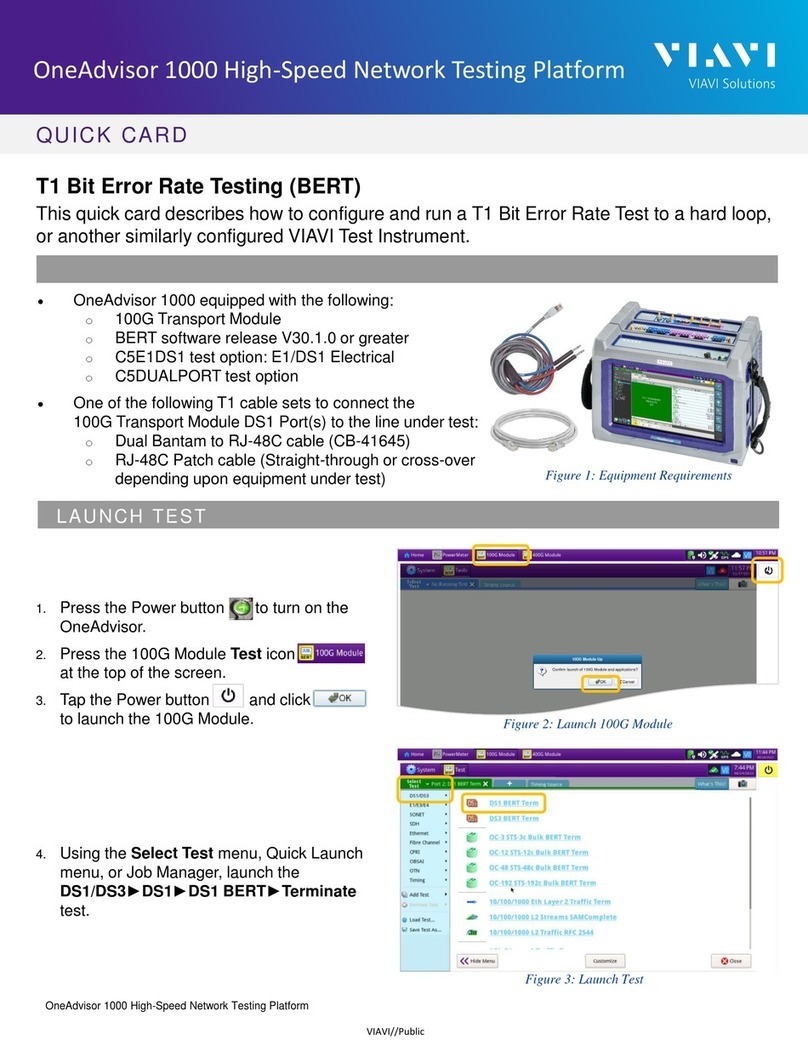
Viavi
Viavi OneAdvisor 1000 Quick Card User Guide
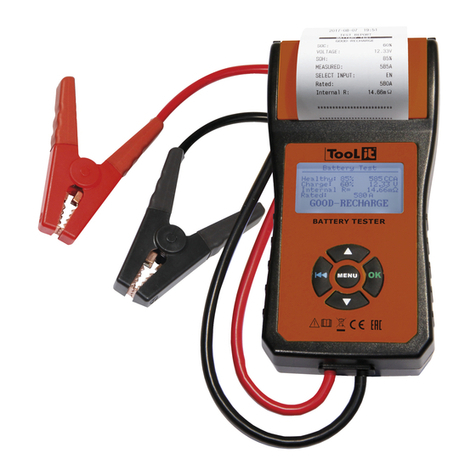
Tool it
Tool it PBT 550 Translation of the original instructions
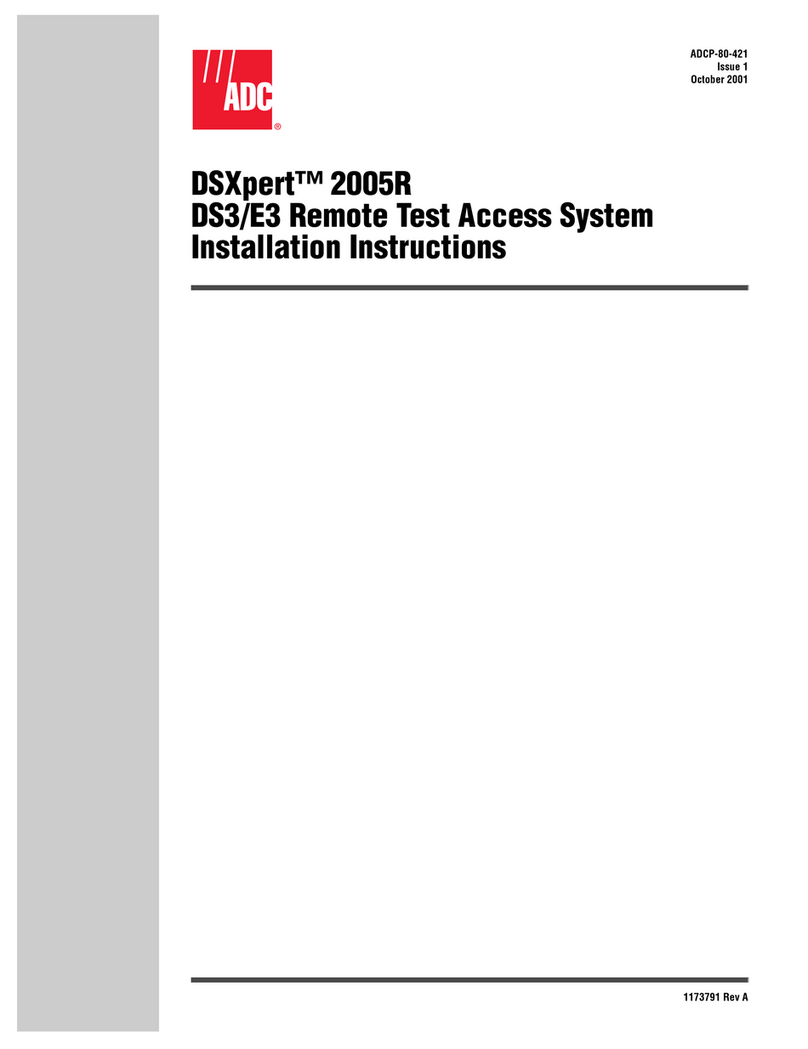
ADC
ADC DSXpert 2005R installation instructions
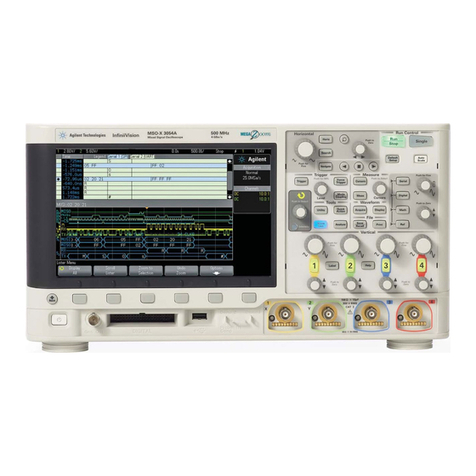
Agilent Technologies
Agilent Technologies InfiniiVision 3000 X- Series Advanced training guide

Industrial Fiber Optics
Industrial Fiber Optics IF-FOM Operator's manual

Rohde & Schwarz
Rohde & Schwarz MXO 4 Series Getting started
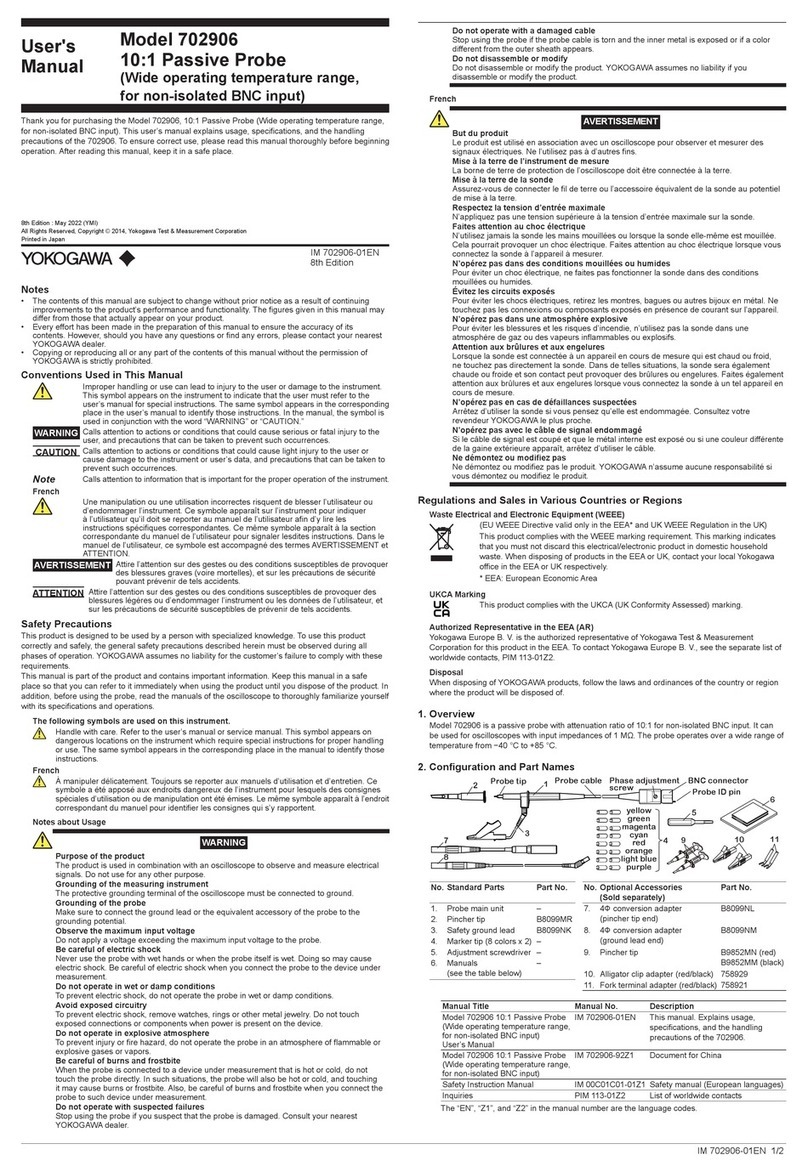
YOKOGAWA
YOKOGAWA 702906 user manual
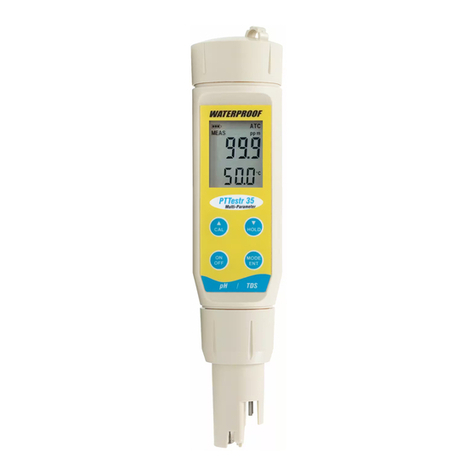
EUTECH INSTRUMENTS
EUTECH INSTRUMENTS ECOTESTR PH 2 operating instructions
Inficon
Inficon ULTRATEST UL3000 Fab PLUS operating instructions
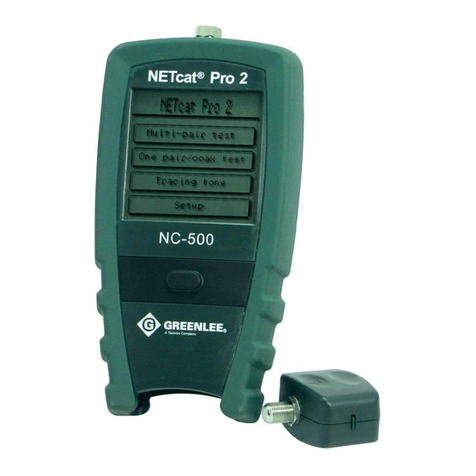
GREENLINE
GREENLINE NETcat Pro NC-500 instruction manual
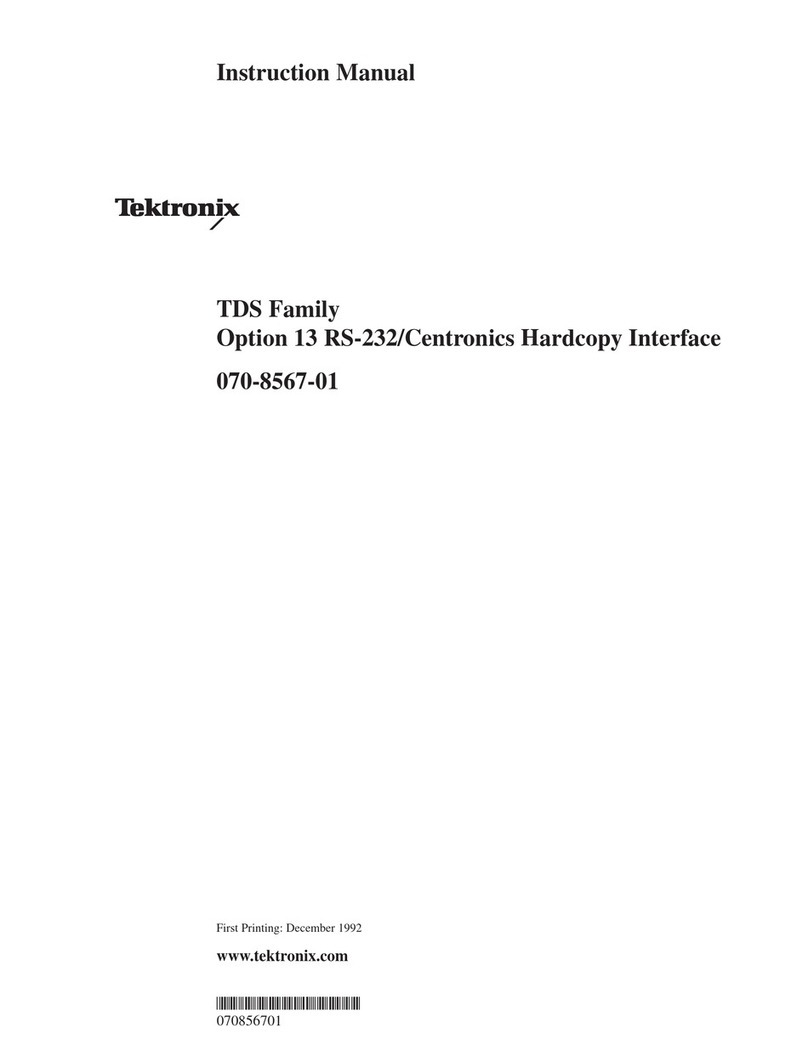
Tektronix
Tektronix TDS 400 Series instruction manual

